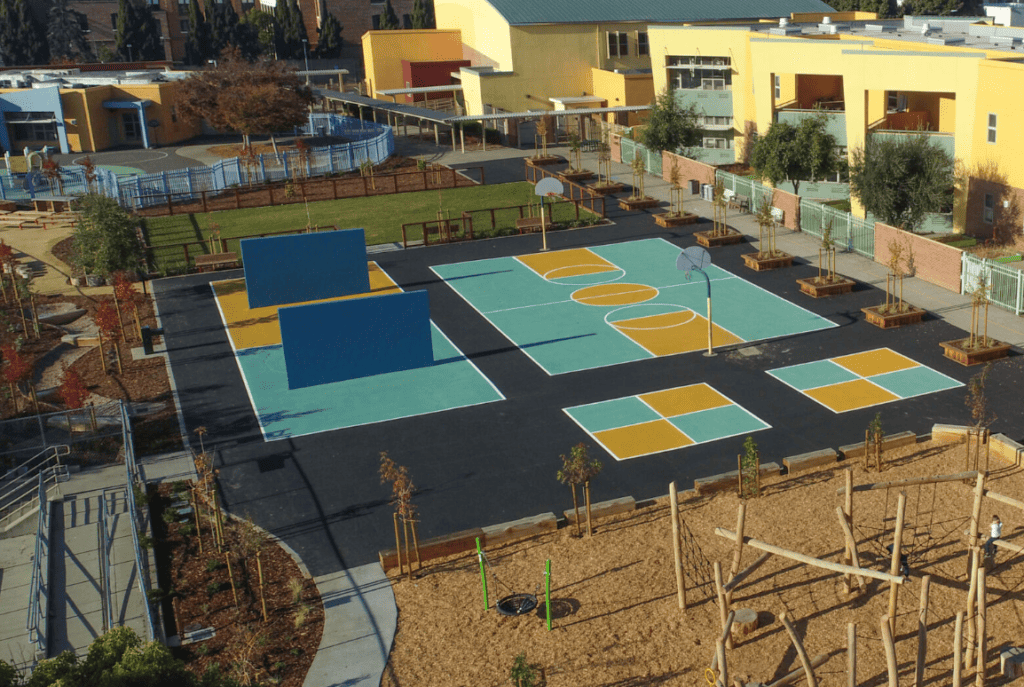Imagine a conventional schoolyard: one covered in asphalt that can get over 20 degrees hotter than the air temperature, with not a single shade tree to provide relief. In the winter, stormwater pools on the acres of concrete, flooding facilities and making roads impassible, keeping young people from accessing their schools. This is the reality for many school campuses in California where the average school has only 9% tree cover and is dominated by asphalt or concrete.

Now compare this with a schoolyard where ample tree canopy provides shade and greenery creates a cooler oasis on hot days. During heavy rains, runoff is channeled into vegetated areas that absorb the water rather than letting it pool and flood. Young people spend time surrounded by nature, rather than bare concrete.
This second type of schoolyard is called a green schoolyard, or a living schoolyard, and it’s what we and many other organizations want to see schools in California transformed into.

Benefits of Green Schoolyards
Green Schoolyards America describes green schoolyards as spaces that “transform asphalt-covered school grounds into park-like green spaces that improve children’s well-being, learning, and play while contributing to their communities’ ecological health and climate resilience.” They can provide a host of benefits to students, teachers, and the community, including:
- Protecting students from extreme heat by creating a cooler environment compared to asphalt-covered campuses.
- Allowing water to sink into the ground, minimizing flooding during storms.
- Capturing and filtering out pollutants in stormwater, keeping contaminants out of our waterways.
- Helping to increase concentration, reduce stress, and boost academic achievement in students.
- Providing hands-on learning opportunities to teach students about environmental issues.
- Adding much-needed green spaces available for community recreation during non-school hours.
| School Report Card Activity Do you have a child or student interested in learning about how their school environment affects them? Try out this student-oriented School Report Card activity that guides students through evaluating their schoolyard, identifying shortcomings, and developing solutions to making their school more green. |
Why We Want to See More Green Schoolyards
Save The Bay has recently begun advocating for more green schoolyards because they are part of our work to ensure cities are using nature-based solutions to become more flood resilient. As climate change leads to more extreme storms, the Bay Area will need the proper infrastructure to channel runoff away from buildings and streets. School districts, which are among the largest landowners in most US cities and are often dominated by asphalt and concrete, are an essential part of the solution.
One of the barriers to expanding green schoolyards in the Bay Area is the lack of resources and funds for constructing and maintaining green schools. We have begun exploring several approaches to advocating for more green schools in the Bay Area:
- School by School: Work directly with individual schools and help acquire grant funding to design and build a green schoolyard, as our partners at the Trust for Public Land have done in Oakland.
- School District Planning: Work with school districts to create a plan to fund and prioritize schools for conversion to green schoolyards. An example of this is Oakland Unified School District which worked with Trust for Public Land and Green Schoolyards American to create a green schoolyards policy and implementation plan.
- Statewide Policy: Pass state legislation to create green schoolyard guidelines at the state level. SB 394, the Master Plan for Healthy, Sustainable, and Climate-Resilient Schools bill, was passed by the California legislature this legislative session but was unfortunately vetoed by the Governor.
| Learn More Want to learn more about green schoolyards? Check out the Greening Our Cities webinar in which we chat with Kira Maritano from the Trust for Public Land about green schoolyards and climate resilience. |

















































